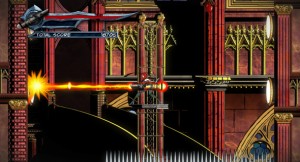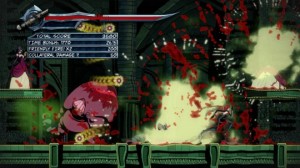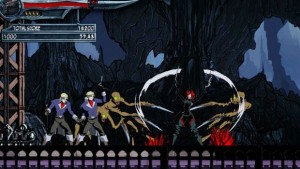 From the opening title screen to the first few minutes of action, BloodRayne: Betrayal is stunningly beautiful. Like the titular star of the game, the presentation is brash, over the top and savagely impressive. For those with a love of 2D sprite art and anime, BloodRayne’s foray into 2D side scrolling slaughter has the same jaw dropping impact as the very best sprite based titles like Street Fighter 3: 3rd Strike and Blaz Blue. If I had to imagine what games would look like in the future when I was fourteen years old and playing games on the Mega Drive and SNES, I would imagine a title that looked and played like BloodRayne: Betrayal.
From the opening title screen to the first few minutes of action, BloodRayne: Betrayal is stunningly beautiful. Like the titular star of the game, the presentation is brash, over the top and savagely impressive. For those with a love of 2D sprite art and anime, BloodRayne’s foray into 2D side scrolling slaughter has the same jaw dropping impact as the very best sprite based titles like Street Fighter 3: 3rd Strike and Blaz Blue. If I had to imagine what games would look like in the future when I was fourteen years old and playing games on the Mega Drive and SNES, I would imagine a title that looked and played like BloodRayne: Betrayal.
Perhaps the word “played” in the last sentence is the most telling. BloodRayne not only “looks” like a game of the SNES era (albeit a gorgeously updated one extrapolated into current gen hardware), but also “plays” like those games too. Rooms full of spikes, moving platforms, gelatinous enemies and Mode7-style sprite scalling and rotation abound throughout the castle, dungeon and crypt levels you will explore throughout the game. One thing that wouldn’t be allowed in the 90’s is the unbelievable gore and blood that’s shed by BloodRayne. Even her checkpoints are blood fountains from which she drinks with a dainty teacup. Meanwhile, her enemies spurt arterial fountains of their own as they are disembowelled, beheaded and otherwise transformed into quivering, bloody chunks.
 The shadow of the Castlevania series looms over the whole experience, but its a tonal influence rather than a gameplay one. None of the RPG trappings of Konami’s rival vampire-focused franchise are in evidence, but the settings, enemies and even operatic, bombastic soundtrack are all there. In particular, the anime-gothic architecture and enemies and the J-Metal/Orchestral score is very close to something like Dawn of Sorrow. This is meant as a compliment; Betrayal’s OTT audio complete with bloody squelches and female grunts played out over a background soundtrack of ridiculously elaborate strings and overdriven guitars is pitch-perfect for the content of the game. Throughout the campaign I kept expecting Nightwish songs to start playing during the boss fights.
The shadow of the Castlevania series looms over the whole experience, but its a tonal influence rather than a gameplay one. None of the RPG trappings of Konami’s rival vampire-focused franchise are in evidence, but the settings, enemies and even operatic, bombastic soundtrack are all there. In particular, the anime-gothic architecture and enemies and the J-Metal/Orchestral score is very close to something like Dawn of Sorrow. This is meant as a compliment; Betrayal’s OTT audio complete with bloody squelches and female grunts played out over a background soundtrack of ridiculously elaborate strings and overdriven guitars is pitch-perfect for the content of the game. Throughout the campaign I kept expecting Nightwish songs to start playing during the boss fights.
The actual gameplay owes a massive debt to titles like The Dishwasher Samurai and Shank. The combat is fast and brutal, involving simple combos combined with a dash move to avoid enemy attacks. By stringing together dashes, jumps, grabs and quick strings of slashes with your blades interspersed with occasional shooting with your guns at long range, streams of human and humanoid opponents are turn into clouds of bloody mist. Unique mechanics abound throughout the combat. You are able to “infect” enemies by grabbing them, then detonate those infected enemies with the press of a button to take out larger groups. Stunned enemies can also be grabbed, with BloodRayne sucking their blood to restore her health.
 Early on though there are problems with the combat. Its fairly difficult at first, and little help is given to the new player. It’s never clear what the most effective tactics are for taking on large groups of enemies, and the help system is a few screens of static images and text with some tips and tricks rather than something far more helpful like a video tutorial or even some training sections at the beginning. Most of the actual problems in the combat comes from Rayne’s animation which seems to take precedence over responsiveness. She may look gorgeous in action, but getting her to do what you want feels impossible and as a result she feels awkward and sluggish to control.
Early on though there are problems with the combat. Its fairly difficult at first, and little help is given to the new player. It’s never clear what the most effective tactics are for taking on large groups of enemies, and the help system is a few screens of static images and text with some tips and tricks rather than something far more helpful like a video tutorial or even some training sections at the beginning. Most of the actual problems in the combat comes from Rayne’s animation which seems to take precedence over responsiveness. She may look gorgeous in action, but getting her to do what you want feels impossible and as a result she feels awkward and sluggish to control.
There are a number of factors that exacerbate this feeling of clumsiness you experience while playing. Bloodrayne can’t duck, and although she has a low attack of sorts, it can be hard to hit small crouching enemies. There are also an abundance of flying wasps and other pests which are too small to easily hit and as a result are deeply unsatisfying to fight against. Meanwhile Rayne’s jump is pitifully weak, but she has a manoeuvre where turning quickly allows her to jump much higher, a little like in Mario 64. This looks nice, but in practice means you spend a lot of time running back and forward somewhat comically, and often straight into groups of enemies. You never stop feeling like you should be able to double jump, and trying to pull off the tuning jump manoeuvre in cramped spaced is maddeningly difficult. There’s a wall jump, but its annoyingly inconsistent in where it can be used. Finally, the dash ability which takes you through and away from enemy attacks seems unresponsive and doesn’t seem to cancel you out of other animations meaning that you often press it to no effect just as enemies are about to hit you. Again, the developers would have done well to look at The Dishwasher Samurai, or (even something like Arkham Asylum), to see how enjoyable a combat system can be when it allows you to react instantly to enemy attacks rather than force you to wait for your own animations to play out.
 The high difficulty of the game is alleviated somewhat by your ability to harvest enemies blood for health. This seems like an inelegant solution though, scrapping through levels whilst being constantly hit, but surviving by constantly draining enemies is little fun. Worse, the range on the grab animation is pitifully short and its often unclear exactly when you can use it on an enemy at all. In other games of this sort that are successful, their combat systems seem forgiving with the range and reach of their moves, but in BloodRayne there’s a level of pixel-precision required that’s seldom fun. Its really sad, as with just a bit more balancing you get the feeling that there’s a fantastically complex and rewarding combat system waiting for you. Perhaps its still in there, but I was unable to get good enough at the game to find it. I may be no fighting-game-ninja, but I’ve defeated Ninja Gaiden and many others like it, so its fair to say the game is as likely to be at fault as I am.
The high difficulty of the game is alleviated somewhat by your ability to harvest enemies blood for health. This seems like an inelegant solution though, scrapping through levels whilst being constantly hit, but surviving by constantly draining enemies is little fun. Worse, the range on the grab animation is pitifully short and its often unclear exactly when you can use it on an enemy at all. In other games of this sort that are successful, their combat systems seem forgiving with the range and reach of their moves, but in BloodRayne there’s a level of pixel-precision required that’s seldom fun. Its really sad, as with just a bit more balancing you get the feeling that there’s a fantastically complex and rewarding combat system waiting for you. Perhaps its still in there, but I was unable to get good enough at the game to find it. I may be no fighting-game-ninja, but I’ve defeated Ninja Gaiden and many others like it, so its fair to say the game is as likely to be at fault as I am.
Added to the frustration of combat is the frustration of the platform sections. Occasionally visual effects obfuscate the path you have to take. Added to this, enemies who knock you off platforms to your death are in abundance. At times, the platform sections seem wholly misjudged in their inclusion. As a fighting game the sticky controls are almost forgiveable, but during platforming they are frustrating in the old fashioned, tear your hair out variety.
 The enemy design swings between enjoyable anime monsters to derivative, shapeless masses. Slashing big blobs of gunk that spawn tiny flying mosquitos is rubbish, as is slashing giant malformed, penis-like pillars of flesh that spout up from the ground before they explode. In these instances the controls once again conspire to defeat you. You spend half your time sliding headlong into the fleshy lumps through inertia as you try to slow down, and the other half swinging your blades at nothing but air while too far away. Occasionally clawed monsters or tuxedo wearing bad guys appear though, and the more humanoid enemies are both better designed and more fun to fight.
The enemy design swings between enjoyable anime monsters to derivative, shapeless masses. Slashing big blobs of gunk that spawn tiny flying mosquitos is rubbish, as is slashing giant malformed, penis-like pillars of flesh that spout up from the ground before they explode. In these instances the controls once again conspire to defeat you. You spend half your time sliding headlong into the fleshy lumps through inertia as you try to slow down, and the other half swinging your blades at nothing but air while too far away. Occasionally clawed monsters or tuxedo wearing bad guys appear though, and the more humanoid enemies are both better designed and more fun to fight.
BloodRayne is a frustrating game. There’s a lot to admire in the B-Movie subject matter and there’s an earnesty to its combat system and the debt it owes to classic action platformers. Its gorgeous and at times looks ridiculously fun in action. Sadly its not anywhere near as much fun to play as it is to watch. Its a shame, as with some fine tuning this could have been a wonderful, over the top action game where you felt like a sexy, unstoppable vampiric femme fatale. Who doesn’t want that? Instead, you feel like a slightly confused mosquito; darting all around but only ever being effective in combat accidently if at all. Its a good try from WayForward, but due to the sheer lack of fun you get from playing the game BloodRayne is ultimately as much of a failure as the movies.
5 dizzy blood sucking red-heads out of 10
